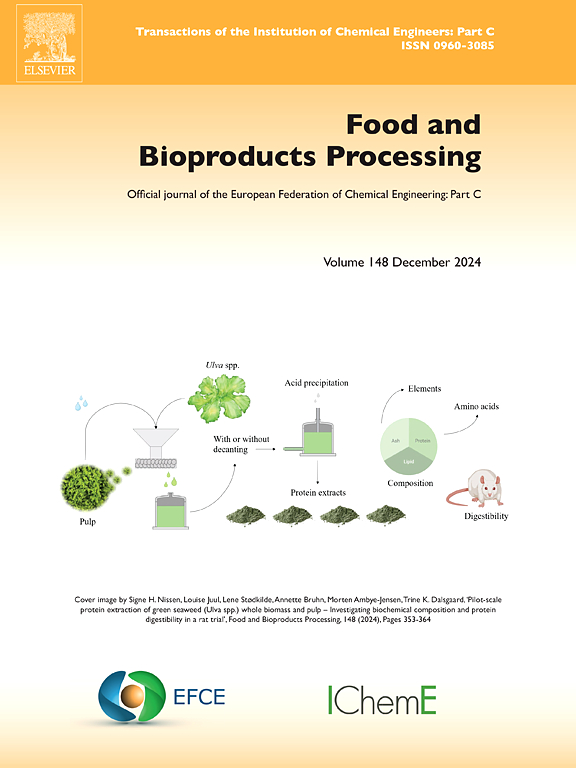基于na2so4的拉伸溶液对螺旋缠绕FO模块中甜菜素浓度最大化的影响因素进行建模和实验研究
IF 3.4
2区 农林科学
Q2 BIOTECHNOLOGY & APPLIED MICROBIOLOGY
引用次数: 0
摘要
从甜菜根汁中浓缩甜菜素的传统工艺由于溶剂的要求和高能耗,成本昂贵。然而,使用正向渗透(FO)工艺浓缩甜菜素提供了一种成本效益高的替代方案,无需相变。该模型和实验研究探讨了使用na2so4为基础的拉伸溶液通过FO工艺提高饲料侧甜菜素浓度的最重要因素。通过室内实验对模型参数进行了估计和验证。此外,还对FO模型进行了仿真,探讨了工艺操作变量、抽液温度和活性膜面积对出口工艺流中甜菜素浓度最大化的影响。结果表明,进口抽吸流量显著提高了出口进料流中甜菜素的浓度。此外,模拟研究了FO膜参数(溶剂渗透率)及其对进料流中进料侧甜菜素浓度的影响。模拟结果表明,在相同的运行条件下,与进口流量为25 L/h时相比,渗透率(1.22 ×10−12 ~ 5.5 ×10−11m/Pa.s)的增加使进料流中甜菜素的富集率提高了66.6% %。相比之下,溶质渗透率的变化对甜菜素浓度的增加影响可以忽略不计。最后,研究得出水渗透性和进水流量是FO膜富集饲料侧甜菜素或其他有机化合物的最重要因素。本文章由计算机程序翻译,如有差异,请以英文原文为准。
Modeling and experimental investigation of factors responsible for maximizing the betanin concentration by spiral-wound FO module using Na2SO4-based draw solution
The conventional process for concentrating betanin from beetroot juice is expensive due to the requirement of solvents and high energy consumption. However, concentrating betanin using a forward osmosis (FO) process offers a cost-effective alternative without phase change. This modeling and experimental study investigated the most significant factors responsible for enriching the feed side betanin concentration by the FO process using a Na2SO4-based draw solution. The module-scale FO transport model parameters were estimated and validated by performing the lab-scale experiments. Furthermore, the FO model is simulated to explore the influence of the process operating variables, draw solution temperature, and the active membrane area to maximize the betanin concentration in the outlet process stream. The results show that the inlet draw flow rate significantly enhances the betanin concentration in the outlet feed stream. Furthermore, simulations investigate the FO membrane parameter (solvent permeability) and its influence on enriching the feed side betanin concentration inside the feed stream. The simulated results show that maintaining the same operating conditions, an increase in water permeability (1.22 ×10−12 to 5.5 ×10−11m/Pa.s) concentrates 66.6 % betanin inside the feed stream more compared to the inlet draw flow rate at 25 L/h. In contrast, variations in solute permeability have a negligible impact on the increase in betanin concentration. Finally, the study concludes that the water permeability and inlet draw flow rate were the most significant factors responsible for enriching the feed side betanin or any other organic compound using FO membrane.
求助全文
通过发布文献求助,成功后即可免费获取论文全文。
去求助
来源期刊

Food and Bioproducts Processing
工程技术-工程:化工
CiteScore
9.70
自引率
4.30%
发文量
115
审稿时长
24 days
期刊介绍:
Official Journal of the European Federation of Chemical Engineering:
Part C
FBP aims to be the principal international journal for publication of high quality, original papers in the branches of engineering and science dedicated to the safe processing of biological products. It is the only journal to exploit the synergy between biotechnology, bioprocessing and food engineering.
Papers showing how research results can be used in engineering design, and accounts of experimental or theoretical research work bringing new perspectives to established principles, highlighting unsolved problems or indicating directions for future research, are particularly welcome. Contributions that deal with new developments in equipment or processes and that can be given quantitative expression are encouraged. The journal is especially interested in papers that extend the boundaries of food and bioproducts processing.
The journal has a strong emphasis on the interface between engineering and food or bioproducts. Papers that are not likely to be published are those:
• Primarily concerned with food formulation
• That use experimental design techniques to obtain response surfaces but gain little insight from them
• That are empirical and ignore established mechanistic models, e.g., empirical drying curves
• That are primarily concerned about sensory evaluation and colour
• Concern the extraction, encapsulation and/or antioxidant activity of a specific biological material without providing insight that could be applied to a similar but different material,
• Containing only chemical analyses of biological materials.
 求助内容:
求助内容: 应助结果提醒方式:
应助结果提醒方式:


